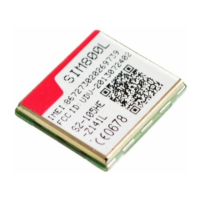
Do you have a question about the SimCom SIM800L and is the answer not in the manual?
| Category | GSM/GPRS Module |
|---|---|
| GPRS Mobile Station | Class B |
| GSM Phase | 2/2+ |
| Supply Voltage Range | 3.4V to 4.4V |
| Operating Temperature Range | -40°C to +85°C |
| USSD | Supported |
| SMS | Text and PDU mode |
| Frequency Bands | GSM 850/900/1800/1900 MHz |
| GPRS Class | 12 |
| Transmitting Power | Class 4 (2W) at GSM 850/900MHz |
| Data | GPRS |
| Coding Scheme | CS-1, CS-2, CS-3 and CS-4 |
| Interface | UART |
| SMS Mode | Text and PDU |
| Voice | Supported |
General description of the SIM800L module, bands, and features.
Lists key features of the SIM800L module, including power and power saving.
Summarizes the various operating modes of the SIM800L module.
Shows the functional block diagram of the SIM800L module.
Illustrates the pin assignment and layout of the SIM800L module.
Details the function and I/O for each pin of the SIM800L module.
Provides the physical dimensions of the SIM800L module.
Covers power supply requirements, voltage range, and bypass capacitor recommendations.
Explains procedures for powering the SIM800L module on and off.
Details minimum functionality and sleep modes for power saving.
Describes methods for providing backup power to the Real-Time Clock (RTC).
Details the serial port and USB interface for communication and debugging.
Explains the behavior of the Ring Indicator (RI) pin in different states.
Covers analog inputs and outputs for microphone and speaker connections.
Explains the SIM card interface, including connection and design guidelines.
Describes the Pulse Code Modulation (PCM) interface for digital audio.
Details the keypad interface, supporting up to 50 keys.
Covers the I2C interface, used for embedded AT applications.
Explains the 3 GPIO pins and their configuration.
Details the Auxiliary Analog-to-Digital Converter (ADC) for voltage measurement.
Describes the Pulse Width Modulation (PWM) output for vibrator or LED control.
Explains the NETLIGHT pin for indicating network status.
Details the STATUS pin for indicating module power status.
Covers the LED driver pins (ISINK) for LCM and keypad LEDs.
Explains the RF_SYNC pin for indicating power consumption during transmit.
Details the GSM and FM antenna ports and matching circuits.
Provides an overview of the module's pin assignment for PCB layout.
Offers guidelines for PCB layout to minimize interference and noise.
Guidelines for tracing RF signals and antenna connections.
Recommendations for laying out power supply traces and GND connections.
Layout considerations for the SIM card interface and ESD protection.
Guidelines for routing audio signal traces.
Tracing recommendations for UART and USB signals.
Illustrates a recommended PCB layout for the module.
Defines the stress ratings beyond which permanent damage may occur.
Specifies the voltage, temperature, and other conditions for normal operation.
Details input/output voltage levels for digital interface pins.
Specifies characteristics for the SIM card interface.
Outlines the output voltage and current for the SIM_VDD supply.
Details the output voltage and current for the VDD_EXT supply.
Specifies input/output voltage and current for the VRTC supply.
Lists current consumption values under different operating conditions.
Provides ESD test results and handling precautions for the component.
Covers RF output power, receive sensitivity, and operating frequencies.
Shows the physical appearance of the SIM800L module from top and bottom.
Illustrates the standard temperature curve for lead-free solder reflow processes.
Defines the Moisture Sensitivity Level (MSL) and floor life of the modules.
Specifies conditions and procedures for baking the modules to prevent damage.
Lists relevant documents for further reference on the SIM800L module.
Defines common terms and abbreviations used in the document.
Provides essential safety precautions for using the cellular terminal or mobile.